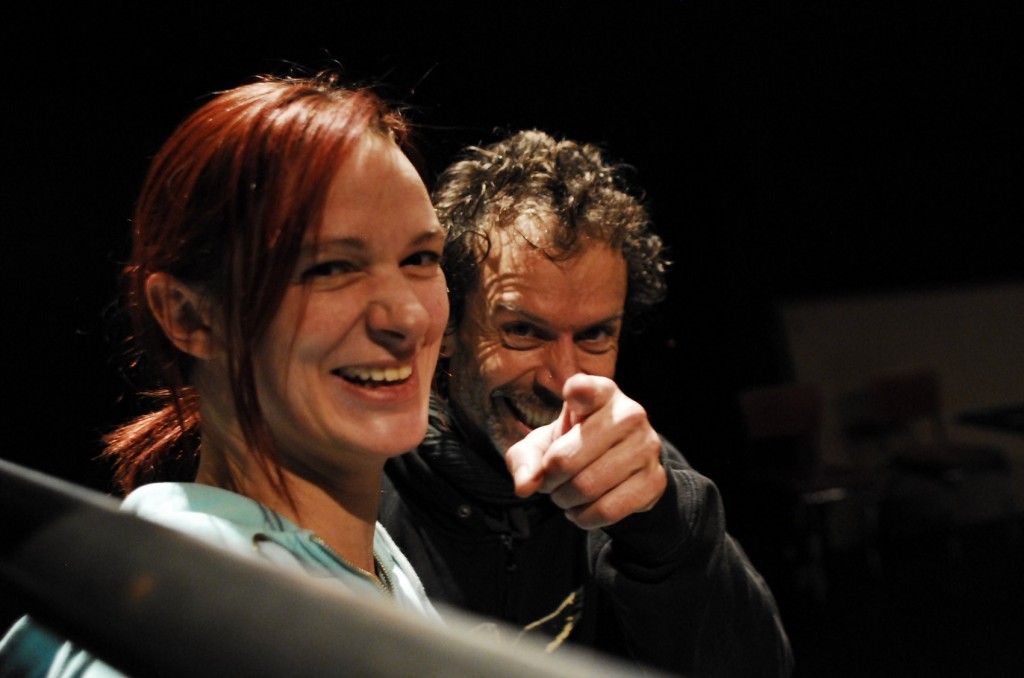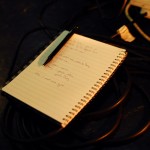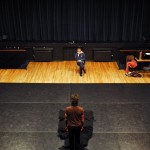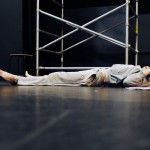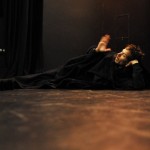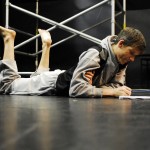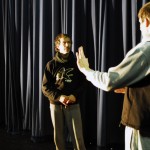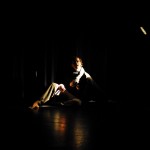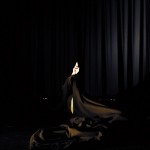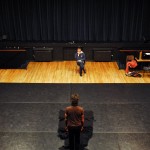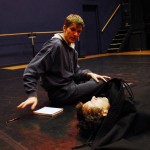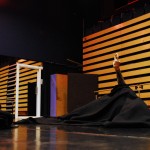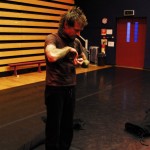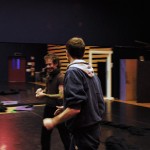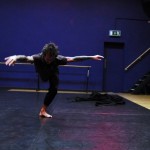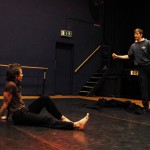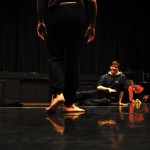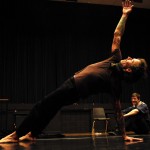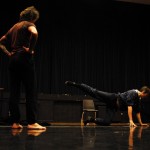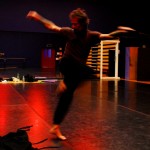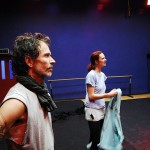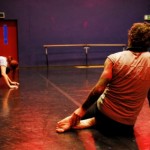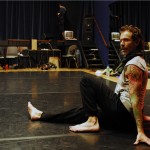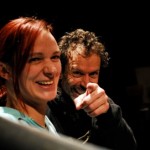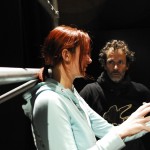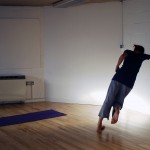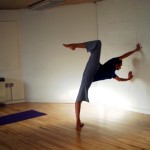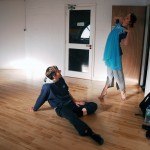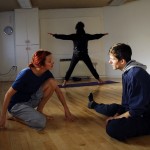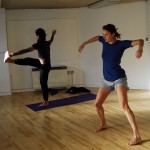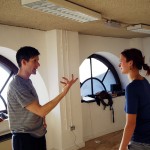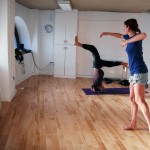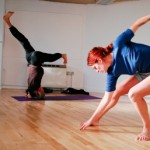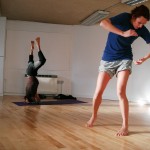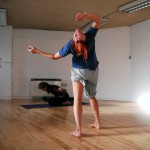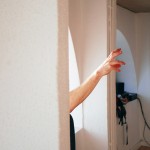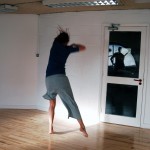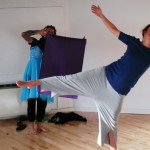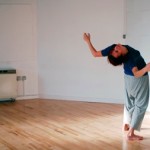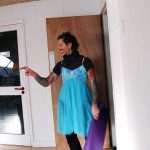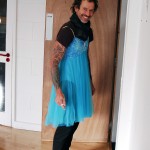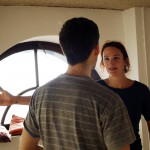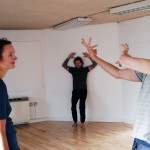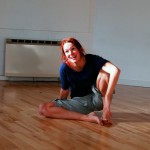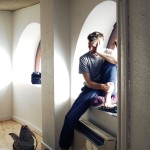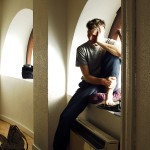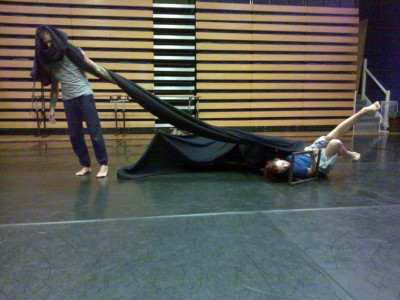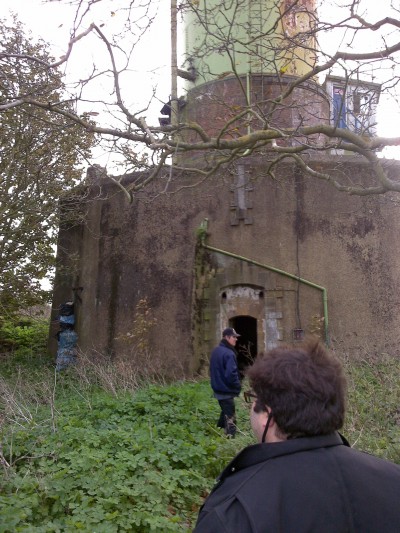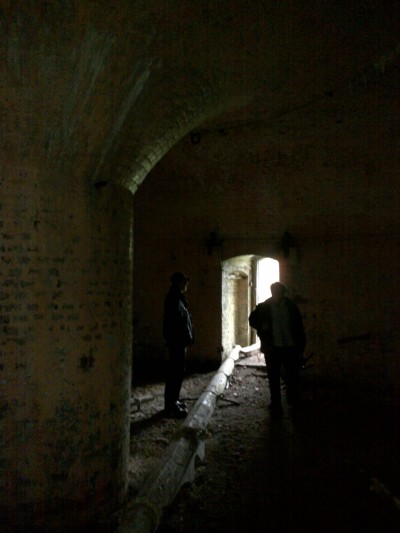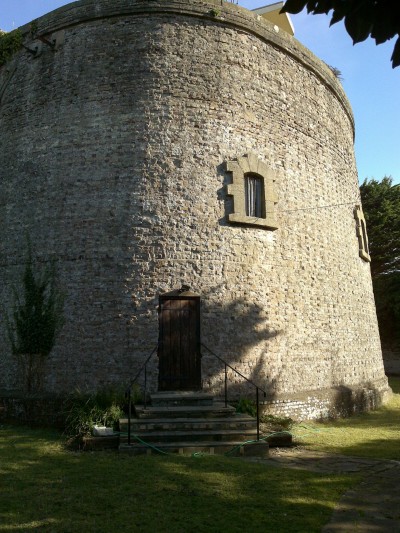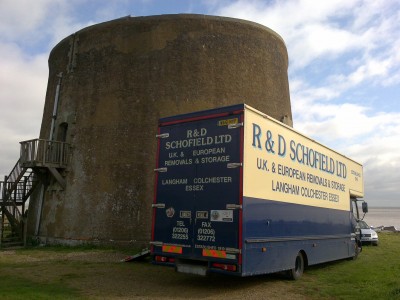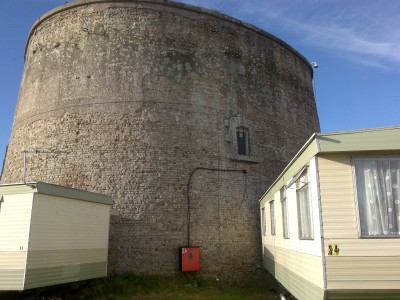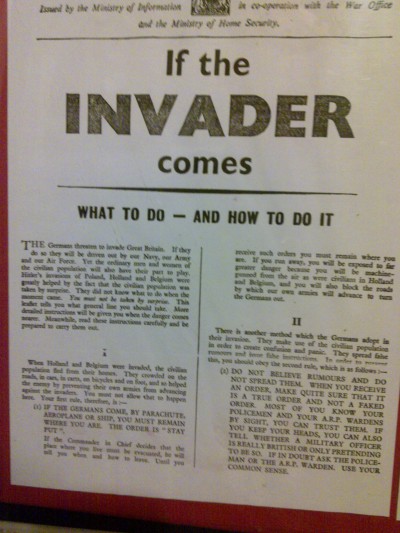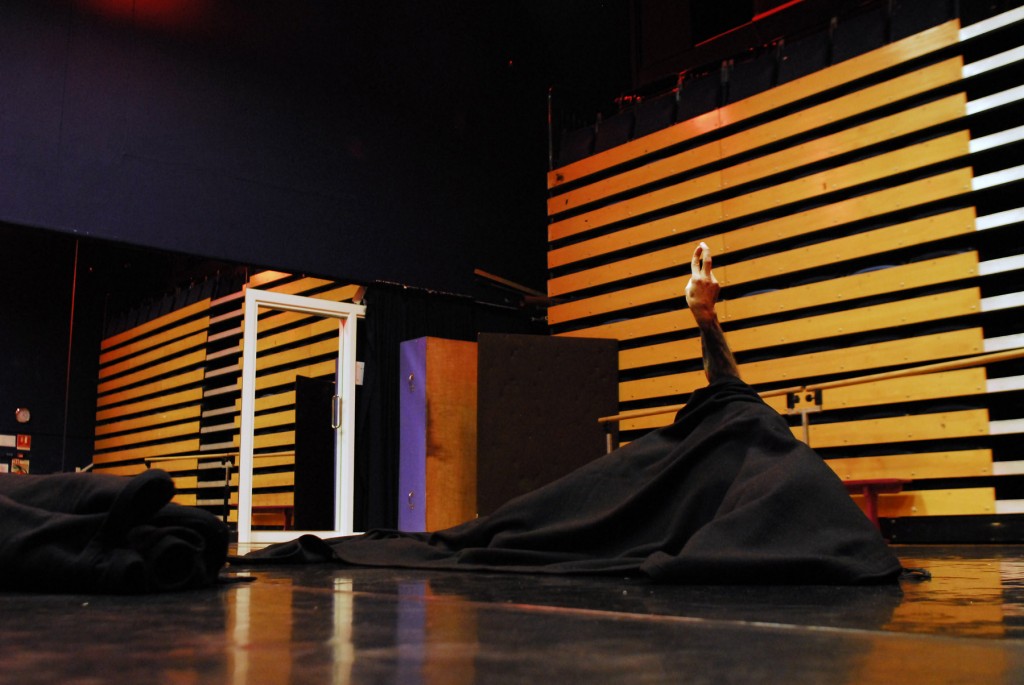 These are photographs by Andy Ferreira and feature the luminous Matthew Morris, the radiant Peggy Grelat-Dupont and me in the studio and stage of the Firkin Crane in Cork. I think Andy has managed to capture the playfulness, beauty and twinkle of these great performers. These aren’t so much images of the dancing, as images of its spirit. That’s a particular achievement given that so much of the time we rehearsed in darkness on the stage and didn’t give him much to work with. But from such challenges beauty blossoms
These are photographs by Andy Ferreira and feature the luminous Matthew Morris, the radiant Peggy Grelat-Dupont and me in the studio and stage of the Firkin Crane in Cork. I think Andy has managed to capture the playfulness, beauty and twinkle of these great performers. These aren’t so much images of the dancing, as images of its spirit. That’s a particular achievement given that so much of the time we rehearsed in darkness on the stage and didn’t give him much to work with. But from such challenges beauty blossoms
Yearly Archives: 2010
Starlight: photos from the Blank Canvas residency
Starlight: Blank Canvas Residency, Firkin Crane Cork
I have the best intentions of blogging while I’m making work, imagining that it would be interesting to share the process of choreographing with its wrong turns and unexpected discoveries. I thought in particular that the research focus of the Blank Canvas residency at the Firkin Crane in Cork would allow me to write something as I went along. But it hasn’t happened so I’m writing now, after the fact.
I came to the residency with the intention of bringing to the theatre the approach that I’ve developed for site-responsive work (Tattered Outlaws, Match, Mo Mhórchoir Féin etc). I wanted to treat as a site, the stage of the Firkin Crane (an idiosyncratic space with its curved back wall). This approach is intended as an antidote to the largely commercial pressure to deliver choreographic product that slots into the interchangeable stage market places that theatres can represent, without acknowledging the physical, cultural and contextual specificity of each particular location. Every dancer knows that specificity when they adapt their performances to whichever stage they find themselves on (a steeper diagonal, a movement curtailed, a focus up or down depending on where the audience is placed in relation to the stage) but in general we work to maintain the fiction that the performance is the same in each venue.
The Open Niche tour was one way of changing that approach, acknowledging that each performance was specific and responsive to its location. To push that further in this residency I wanted to imagine the stage differently, wondering what it would be like to rediscover this defunct communication technology (it’s survived a long time but will the stage still work in 100 years time?)
I’ve worked with Paul McCarthy, a lighting designer who manages the Firkin Crane, to help me research these ideas through a solo for Matthew Morris. Paul remarked before how much energy is required to power the contemporary stage and how little, by comparison, is required to view a movie on a smartphone or even a laptop. This focus on energy made me think about the performer as source of energy, as heat, as movement, as sound and as radiant light. (These ideas have been incubating since the research with Roberta Lima and I hope we can pursue them during her residency in Chicago next year).
From these simple thoughts, embodied in Matthew’s luminous movement, we’ve made an experience for visitors. I don’t think of it as a performance for audience which already fixes a certain relationship of people to space. ‘Visitors’ allows me more possibilities to investigate participation and playful exploration. Keeping that in mind has allowed us to circumvent some of the usual stage conventions.
The working title of the piece is Starlight, a title I’ve had in my mind for Matthew’s solo since we worked together on a commission I did for Crux Dance Company. The piece, like starlight, is mostly viewed in the dark – a darkness that allows the delicate scintillation of the star’s radiance to be visible.
It is a new departure for me but felt right to pursue since it continues an investigation into the relationship I want to establish between my work and an audience/public/participants/visitors. It also continues to investigate space and architecture as well as the eastern-inflected dialectic of light and shade that my work in China has highlighted. Perhaps it remains aware of mortality and as I write that, the image of the sparrow flying through the mead hall from Bede’s Ecclesiastical History of the English People comes into my head:
Your Majesty, when we compare the present life of man on earth with that time of which we have no knowledge, it seems to me like the swift flight of a single sparrow through the banqueting-hall where you are sitting at dinner on a winter’s day with your thegns and counsellors. In the midst there is a comforting fire to warm the hall; outside the storms of winter rain or snow are raging. This sparrow flies swiftly in through one door of the hall, and out through another. While he is inside, he is safe from the winter storms; but after a moment of comfort, he vanishes from sight into the wintry world from which he came. Even so, man appears on earth for a little while; but of what went before this life or of what follows, we know nothing. Therefore, if this new teaching has brought any more certain knowledge, it seems only right that we should follow it.
My aunt, Helen, died while I was in Cork. She was a kind, generous and loving woman.
One final thought about Starlight comes from a text about scintillation or twinkling. The apparent on and off twinkling of a star’s light is not caused by the star’s failure to maintain a steady output of light and energy. It is atmospheric turbulence that momentarily re-routes that energy:
This does not mean that the star’s light is lost for that moment. It just means that it didn’t make it through your pupil to your retina – it went somewhere else in the vicinity of your pupil.
I’ll let you draw your own conclusions….
By the way, knowing who to work with is also an important choreographic skill and I’m pleased that it’s one I’m able to hone with Matthew (and Peggy Grelat Dupont).
In the moment: dance and technology
I was in Dancehouse today to interview John Scott for Imeall. John is collaborating with the renowned video artist and film-maker Charles Atlas on a new production, In the moment. The studio was already like a technical rehearsal with lights, screens, cameras and banks of computers and processing equipment. Charles has worked with Merce Cunningham, with Michael Clark, with Marina Abramovic and with Antony and the Johnsons. He knows a lot, though he wasn’t giving much away when I interviewed him today.
When I watched the beginning of rehearsal it seemed initially chaotic and disjointed in a way I’d find difficult to handle. However, little by little I saw John follow his instinct and make very quick choices about what should be going on. Two pieces of material that initially sat side by side were joined together when John asked the dancer who’d just arrived off a plane from New York to improvise expansive movement across the whole space. Suddenly the two separate pieces of material spoke to one another and a delicious hum of energy developed. The dancers were very quick to respond to and amplify the new possibilities of the choreography. It was great to see.
When you work mostly as a choreographer, you don’t really get a chance to see other choreographers at work. You see the product of their work but not necessarily their process. John’s energy is very different from mine but it was fascinating to see how that energy can make beautiful things happen in a moment. I was reminded that there’s still lots I want to work on and that it’s a joy to see bodies moving in space together.
East Coast Towers: Tower L
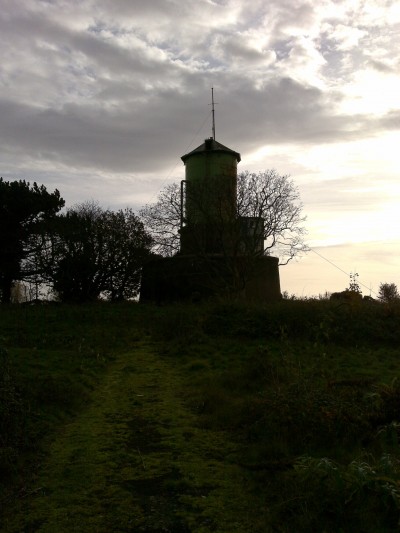 At Tower L, the security guard’s story feels familiar. Dan and I got permission from the developers who own the former HMS Ganges site to visit the tower on their land. The security guard welcomes us and takes us to the tower, lost in a kind of magic garden thicket which muntjac, deer, pheasant, partridge and foxes inhabit. He describes his military background that connects him to the site’s history, recent and distant.
At Tower L, the security guard’s story feels familiar. Dan and I got permission from the developers who own the former HMS Ganges site to visit the tower on their land. The security guard welcomes us and takes us to the tower, lost in a kind of magic garden thicket which muntjac, deer, pheasant, partridge and foxes inhabit. He describes his military background that connects him to the site’s history, recent and distant.
His experience embodies something I’d imagined in relation to the towers in Ireland. I’d wondered what it might be like to be keeping vigil, to be waiting for something that didn’t happen (most prosaically Napoleon’s invasion). What would fill that waiting? What would it feel like? What interior journey might one go on waiting for an exterior one to happen? What resources would an individual have to cope?
The security guard spends long shifts patrolling the grounds on his own. He knows the territory well, the plants and trees, the animals and their routines, the history of the site. He says the job gives him plenty time to think. He is gentle but an unexpected noise sees him shoot purposefully to check its source. This ability to alternate between alert and thoughtful suggests the energy of my dancing in the towers – the fall into interiority balanced by outward action, the stillness containing agitation.
The security guard is my touchstone for now.
Tattered Outlaws: The East Coast Towers
Dan and I have started getting to know the Martello Towers of the East Coast of England. It’s the first step towards making a new piece that will join the Tattered Outlaws of History installation that will come from Ireland to the Jaywick Tower in Essex next Spring. The intention is for Tattered Outlaws to open in April and for the new piece to be added in the Summer, linking two branches of the Martello family.
Getting to know the towers has meant visiting them and performing all kinds of detective work (which makes our research efforts sound much more thrilling than it is in practice!) to find out who owns them or lives in them. It’s mostly phone calls and the occasional note through a letter box that gains us access but it is always worth it to see another tower, to recognise its family resemblance to the others in the series and notice also the distinctive history that makes each one different.
These towers feel quite different to their Irish counterparts. They are bigger and oval but, for the most part, they feel less solitary. In Felixstowe and Clacton, the town has grown up around the towers and in other places, caravan parks and holiday homes crowd around them. Even the towers that are most remote feel less isolated because they have been renovated for use as homes.
But the towers are still quirky and still make me think of transience and permanence. In the past, I’ve thought about the towers’ solidity in contrast the temporary nature of our human intervention in them. However, the fact that some of these towers have been lost to coastal erosion suggests that even that presumed architectural ‘permanence’ is temporary.
I hadn’t intended to be a performing body in this work for the East Coast Towers. My current knee injury combined with a sense that it was time to see what traces I could leave in others when I withdrew from the frontline had suggested that this would be the right strategy and the right time for it. However, when Dan and I (and Tove who was there as assistant) were trying to understand the towers, I couldn’t help but use my own movement as a means of processing my instinctive responses and sharing that with Dan.
Fortunately, this processing doesn’t mean that I will appear in front of the camera but traces of me will. I like the direction we’re taking since it seems an extension of Tattered Outlaws rotating camera that never lingered to focus on the physical performance on the towers. The traces of performance and of human intervention are what seem most resonant to me.
Modul Dance: The first gathering
Modul Dance is another structure to navigate. Artists and dancehouse partners gathered for the first time at the Maison de la Danse in Lyon to get to know each other and begin planning how the opportunity will evolve. Reading the Modul Dance website I see that it was an Artists’ Think Tank but mostly it was a valuable ‘getting to know you’ opportunity and a ‘getting over the anxiety’ opportunity.
Despite knowing we’d been chosen to be there, I and at least some of the other artists couldn’t help but feel that we were speed-dating with the dancehouses and hoping that at the end of the whirlwind we’d have one their affection. Once I could see past my own anxiety, I realised it was equally pressurised for the dancehouses that have come together to make the EU bid that underwrites this project. They’ve negotiated their considerable differences of scale, remit and context to collaborate and now, having been successful in their application, need to work out in practice how what it all means. I hope we artists can help with that.
There are moments when the language jars for me in this process: the language that inadvertently refers to us as ‘young artists’ isn’t just a misrepresentation (I’m not the oldest and anyway, it was a prerequisite that we be experienced) but it implies a power dynamic that places the artists in a subordinate position.
I hope that the choreographers and dancehouses can be mutually supportive in making Modul Dance a multi-faceted success whose architecture houses many different possibilities for creativity, delight and learning. Of course, the more knowledge that the artists have about the governing structure, its budgets, goals and timeframes, the more we can contribute to a common success.
The choreographers are:
- Daniel Abreu / Mercat de les Flors
- Tania Carvalho / EKZ Hellerau
- Hafiz Dhaou and Chatha Aicha M’Barek / Maison de la Danse Lyon
- Claudia Dias / DeVIR CAPa
- Gunilla Heilborn / Dansenshus Stockholm
- Anne Juren / TQW
- Leja Jurisic / Kino Siska Ljubljana
- Ito Kaori / Tanzhaus NRW
- Jasmina Krizaj / Plesna Izba Maribor
- Coraline Lamaison / CDC Toulouse
- Pia Meuthen / Station Zuid Tilburg
- Fearghus O’Conchuir / DanceIreland
- Frauke Requardt / The Place London
- Tina Tarpgaard / Dansescenen Copenhagen
- Perrine Valli / adc Geneva
- Alexandra Waierstall / DDRC Athens
- David Wampach / CND France
Dialogue on Imeall
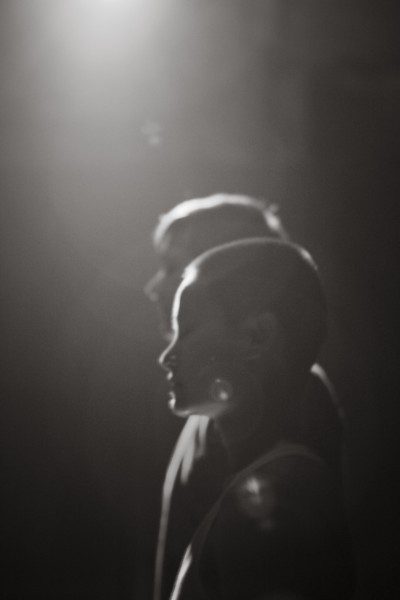 It was great to see Xiao Ke being interviewed on Imeall last night. The programme focused on Ireland’s cultural contribution to the Shanghai Expo and though I had returned by the time the Imeall team got to Shanghai, they interviewed Xiao Ke about our collaboration.
It was great to see Xiao Ke being interviewed on Imeall last night. The programme focused on Ireland’s cultural contribution to the Shanghai Expo and though I had returned by the time the Imeall team got to Shanghai, they interviewed Xiao Ke about our collaboration.
I get a kick out of knowing that Irish, contemporary dance and China come together in the idiosyncratic experiences I’ve had but mostly I’m moved that, when asked about the value of our collaboration, Xiao Ke answered that it doesn’t matter in comparison to our friendship.
Xiao Ke’s interview starts at 3:50 in Part 1 of the show here

Starting – resuming
Stéphane’s visit to London has allowed me some precious time in the studio and a chance to open myself to the thoughts that movement stirs in me. It has also left me with precious material to look over in video form and sensations to process of watching him dance that already nudge me a step closer to the new piece.
I taught him material from the Mo Mhórchoir Féin solo as the starting point for a deconstruction of that movement as sacred text. It makes particular sense with Stéphane since he was with me during my residency at the Red Gate Gallery in Beijing last year, when that material first emerged (who knew it would end up in a church in Dolphin’s Barn and on RTÉ?). I also asked him to recall whatever physical memories remained for him of our improvisations in Beijing – something he did with evocative attention to quality and detail.
Seeing the result has made me think, as I often do, about what wasn’t there – what had been, who isn’t – and how that absence is palpable in the presence of what and who is.
ODA Residency – not this Olympics
What I see as urban is a heterogeneous structure that allows for grassroots development and for alternative communities to coexist.
Svetlana Boym, professor of literature and design at Harvard University
Dominic and I were not successful in our ODA residency proposal, I learned today, but reading a Der-Speigel article about the gentrification of Berlin’s alternative spaces, I realised that there is still scope to continue a creative investigation that celebrates ‘heterogeneous structures’ and the spaces within urban development that allow for the co-existence of alternative communities. I’ll clearly have to read Professor Boym’s work.
Olympic Residency
I’ve just had my final interview to try and become Artist in Residence for a year at the offices of the Olympic Delivery Authority in Canary Wharf and on the Olympic site on which the ODA is building. I don’t really know whether they were looking for a choreographer. The language of the initial brief which looked for a team of artist and curator didn’t immediately suggest that they were, but, emboldened by the sense that my bodies and buildings experience qualified me to make an informed pitch, I applied with Dominic Campbell as my curator/producer/colleague.
My rationale for the proposed residency is that the Olympic regeneration process is already a huge choreography. It’s about setting structures in space that determine the movement of individuals through the city now and for generations to come. My particular interest is in seeing how that macro-choreography is experienced physically, emotionally and psychologically in the bodies of individuals who deliver, receive and ultimately reshape that regeneration choreography.
Dominic’s experience of programming events across cities and countries can help expand my concern with individuals to a bigger scale – just as the huge spectacle of the Olympics is built on the singular endeavour of individual athletes.
I think the challenge for me in presenting this proposal is that dance occupies a particular place in the Olympic discourse. It ‘benefits’ from being close enough to sport for its physicality to be acknowledged. It is useful as a tool for mass participation. It fits into the grand spectacle of the open ceremony. It gets people sweating.
But people who push dance in that direction forget in their hunger to be recognised by the Olympic discourse that dance is a form of expression and that it can provide a different prism for reading the psychological and emotional journeys that individual athletes express in their physical performances on the track and field. When athletes race they reveal deep narratives about themselves, the commitments and sacrifices they’ve made to bring themselves to readiness for competition, their hunger to win and the appetite for life that might represent. That’s the kind of dance I’m interested in.
Here’s hoping the ODA panel are excited by the idea of helping me make that happen.

